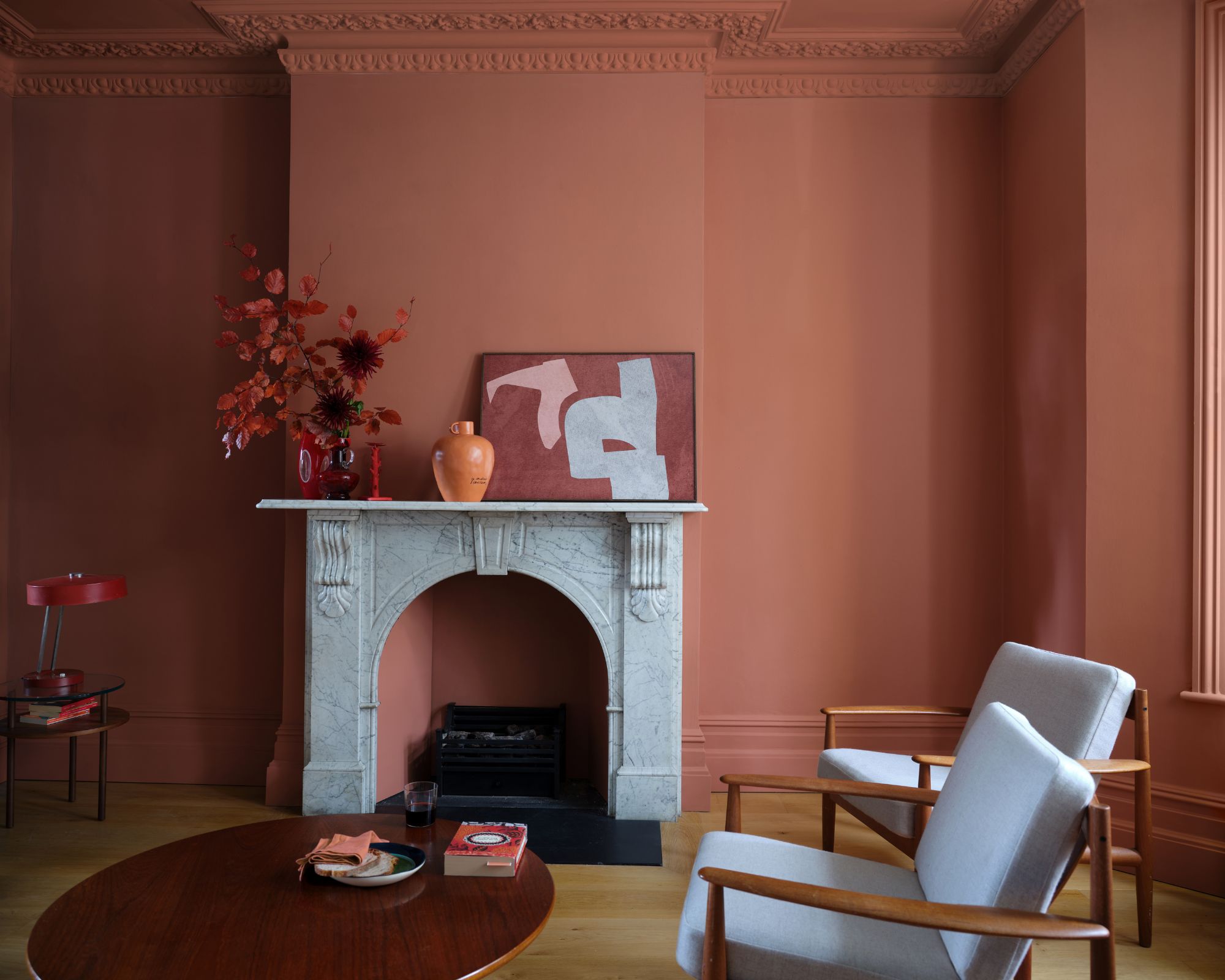5 time-saving painting lessons I've learned from color-drenching living rooms as an interior designer – for a professional finish
You can't rush a paint job, but you can avoid time-consuming mistakes: here are the lessons I've learned from color-drenching


Painting the walls, woodwork, and ceiling the same color is a great way to make a space feel polished and sophisticated. On a practical level, it means there is no need for painter's tape, removing some of the more fiddly aspects of painting a room off your to-do list.
Not only does it look great and potentially save you time, but from my experience, it can also make a room feel larger. This is because when a whole room is painted the same color, the edges are blurred and the eye isn't drawn to its perimeter. Instead, there is one continuous color, whichever way you look.
As you can tell, I'm a fan of this paint trend – if you are thinking of going for this monochromatic look (good choice) I've shared my interior painting tips and lessons from color-drenching living rooms below, so you can get a pro finish first time around.
5 lessons from color-drenching living rooms
If you are still deliberating over color charts, consider the best colors to make your living room happy, and read up on the wall-painting mistakes to avoid.
1. Prepare well, with the right tools

On a recent living room redesign that I worked on with a client, we spent an entire day preparing the room, and this made all the difference. We made a list of all the tasks, which I've outlined below, and gradually ticked them all off. Painting is tiring, especially when you're painting the ceiling, too. So give yourself plenty of time to prepare. This will mean that come paint day, you're ready and raring to go with clean walls and all the tools you need.
- Empty the room – Move as much furniture as possible into another room. This might create some chaos, with living room furniture invading the dining room, for example, but it's not for long and will avoid paint splatters and frustration.
- Get all your paint supplies together – Gather all of your painting supplies: cans of paint, rollers, paint brushes, paint trays, sanders, a knife for opening the paint can, a paint mixer, step ladders, dust sheets, and so on. Choose high-quality paint brushes, at Amazon, to make painting quick and easy.
- Paint over any samples – If you have painted your samples onto the wall (which we would always recommend doing after painting them on paper, as it gives you a clear idea of how the paint looks on the wall), then it's time to paint over them in white. This might take two or three coats, depending on how dark the paint samples are, but it's an important step in preparing walls for painting.
- Clean the ceiling and the walls – Dust the ceiling, coving, walls, windowsills and baseboards, and then wash the walls and doors with warm soapy water on a sponge. Cleaning walls before painting is time-consuming but it ensures your paint will go on smoothly. Check for any lingering dust, dirt, or grease on baseboards and behind heaters.
2. Choose the right paint (and enough of it)
Color-drenching means painting walls, woodwork, and metal radiators if you have them. After speaking to paint professionals at a local DIY store, we went for Calke Green by Farrow & Ball in 'dead flat' as this can go on any surface. If we had color-matched Farrow & Ball in less high-quality paint, we would have needed different paint finishes for the woodwork and radiator, meaning we'd need to cut in and swap paint brushes for the different surfaces. We simply didn't have time for this and wanted to keep things as straightforward as possible.
We also didn't buy quite enough paint the first time around, which slowed us down significantly. The ceiling is patterned and it took more paint for us to get into all the little gaps. We initially bought 7.5 liters to do the whole living room and ceiling but needed an additional 2.5 liters to finish everything off.
Design expertise in your inbox – from inspiring decorating ideas and beautiful celebrity homes to practical gardening advice and shopping round-ups.
3. Recruit friends

As with most DIY projects, painting a room tends to take longer than we expect, which is why it's a good idea to get friends and family involved. Eventually, you reach a point of having 'too many cooks' but four or five people can comfortably work together in a living room, and this will speed up the process dramatically.
Make sure you have enough equipment to go around and if necessary, pick up an additional step ladder, at Amazon, and paint rollers, also at Amazon, so lots of people can work at once.
Take plenty of breaks, have food and drinks on hand, and remember to keep the room well-ventilated to keep you and your team of painters energized.
4. Paint towards the window when painting the ceiling
There are different schools of thought around ceiling painting mistakes, particularly around whether you should paint away from or towards the primary source of light when painting a ceiling. Following advice from family members, I always use the roller to paint lines towards the window rather than away from it.
If you go perpendicular to the source of natural light when painting with a roller, there's a chance that you'll see shadows where the roller lines are, as the light will be coming in right across them. Thankfully for us, the textured pattern on the ceiling made any lines less obvious, but if you are painting a ceiling that isn't textured, it's worth taking extra care over this.
Ceiling Paint Roller | $39.99 at Amazon
This long-handled ceiling paint roller is ideal for working from the ground and reducing the strain on your neck and arms when painting a ceiling.
5. Take your time

It's natural for us to want to make our living room paint ideas a reality as quickly as possible because decorating is disruptive and messy. Plus, we want to enjoy our new spaces as soon as we can.
But mistakes are made when we rush, and when you're using stepladders and tools, it's important to work safely and steadily. To avoid stepping on your paint tray, spilling paint all over your floor, or potentially injuring yourself, go for a 'less haste, more speed' approach.
FAQs
What are the mistakes to avoid when color-drenching?
'Not prepping properly is the biggest mistake in my opinion,' says Barry Krall, brand president of Groovy Hues. 'It's hard work but worth it in the long run. Calculate how much paint you need and buy it all at once, especially if you are color-matching, to ensure the color is the same throughout.'
Barry also cautions against overloading the brush or roller with paint, as this can lead to drip marks that will need to be sanded down and repainted.
It's good to have some paint left over for touching up paint on walls when the inevitable scuffs happen, and to save you from looking at those annoying uneven spots.
If you end up with too much paint left over and aren't sure how to dispose of paint properly, you can head to our guide on ways to get rid of it responsibly.

Millie is a freelance writer and qualified interior designer based in Sheffield. She has many years of experience in the world of content and marketing, and previously worked as the head of Solved at Homes & Gardens. Before that, she worked in SEO at News UK in London and New York. She has a first-class degree in French and Italian from UCL and loves to weave decor into her home that reminds her of time spent living and studying in Bologna. Millie believes a clutter-free space that you love coming home every day is the best secret weapon for our well-being.
